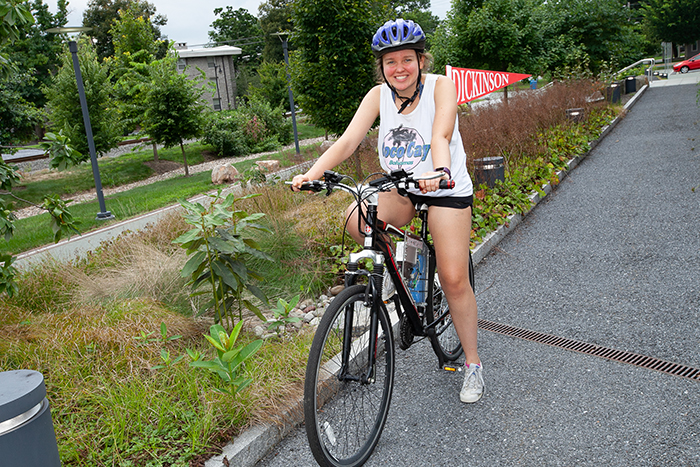Dickinson College Professor and Students Build Electric Bikes to Highlight Energy-Efficient Commuting Alternatives

Kristen Kozar '20, an intern with the Center for Sustainability Education, takes a ride on the rear-wheel-drive electric bicycle. Photo by Carl Socolow '77.
E-bike prototypes come to Dickinson
by Kandace Kohr
Though many environmentally conscious commuters have adopted biking, long distances and hilly terrains can pose problems and still prevent wider adoption of this energy-efficient driving alternative. Working with Professor of Physics Hans Pfister and the Center for Sustainability Education (CSE), Dickinson College students recently did more than imagine a potential solution—they built one (or to be exact, three).
From the Ground Up
In fall 2017, Pfister and three of his students applied for a grant from the Sustainability Education Fund, which is administered by CSE, to construct two electric bicycle or e-bike prototypes for the college. In addition to the college’s existing Red and Green bike-share programs, these new e-bikes would offer a more powerful and longer-range alternative to driving. As an excerpt from the final report explained, “if the student uses a bicycle instead of an SUV, only one twentieth of the mass needs to be moved, resulting in a very significant savings of energy and equally significant reduction of CO2 emissions.”
Over a six month period, a group of about 15 students, including CSE’s interns and several helpers from The Handlebar, carved out a few hours each week to roll up their sleeves alongside Pfister and transform the skeleton of three bicycles into a lean, green motorized machines. Realizing the high costs of e-bikes on the market today—which can range from $1,000 to $8,000 for a finished e-bike or $200 for a conversion kit—the group wanted their design to be affordable for the average college student or cash-strapped commuter. So they adopted a from-the-ground-up approach, purchasing the necessary parts separately, building the battery assembly and making the chargers from used laptop chargers.
Breathing new life into old technology
Ideal for those who live within 10 miles of Dickinson’s campus, the completed e-bikes now provide a new model for energy-efficient transportation, assisting with hills that might make potential bikers opt for gas-powered vehicles instead.
"We would hope that through the introduction of a few e-bikes to the Dickinson community, many members of the Dickinson community might embrace the e-bike as a convenient, inexpensive, economically smart and sustainable way of transportation," says Pfister. "In the same vein, I hope that many members of the Carlisle community would embrace e-bikes as affordable, incredibly economic and sustainable modes of transportation."
At full charge, one e-bike can travel 20 to 30 miles at a speed of up to 30 mph, and further testing is planned to potentially increase the bikes' range. In addition to modifying Pfister’s own bike, the group created one front-wheel- and one rear-wheel-drive e-bike to test handling, power and overall riding experience between. The modified bikes came from a donation to The Handlebar.
Both versions contain a 500-Watt brushless hub motor. Hub motors work by turning stored electricity into power. An electric current runs through tightly coiled wire that sits between the poles of a magnet, and when the coil spins, that force can turn a wheel and power a machine. CSE plans to use the e-bikes as promotional vehicles to increase awareness of sustainability efforts on campus. Dickinsonians might see them at campus events such as the annual Bike to Farm Potluck, open houses at The Handlebar or Move-In Day, where CSE staff and volunteers will show off the new energy-efficient vehicles and answer questions.
Learn more about biking at Dickinson.
TAKE THE NEXT STEPS
Published August 17, 2018